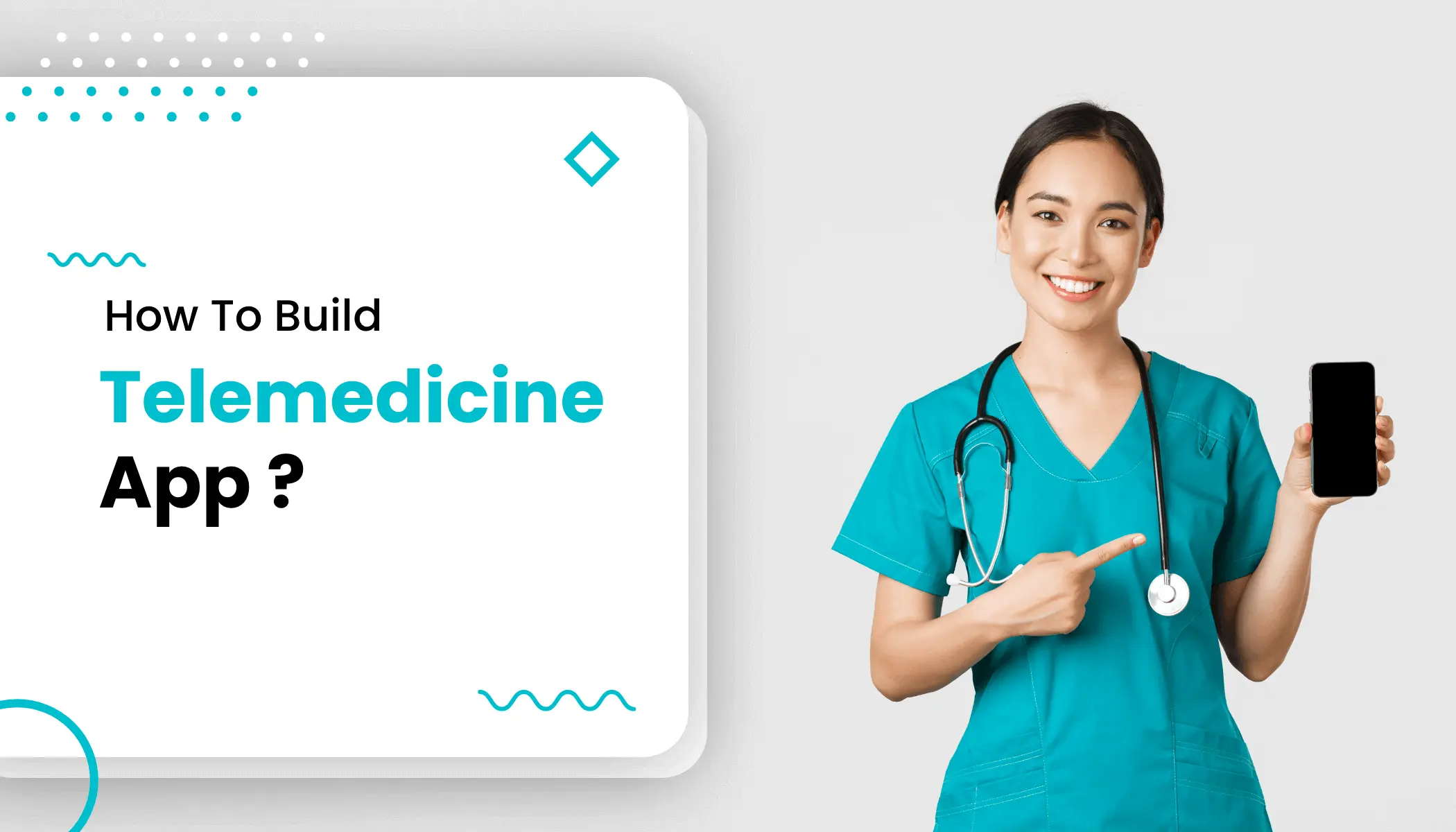“Mobile is the future of online.”
With people shifting to mobile apps, the demand for remote delivery of healthcare services is increasing. Telemedicine apps allow healthcare professionals to evaluate, diagnose and treat patients online. Patients, too, have the advantage of convenience and flexibility to approach desired doctors. As the telemedicine industry is booming, entrepreneurs look forward to building mobile telemedicine apps.
However, they are looking for a step-by-step guide to building a telemedicine app. In this article, we will cover “how to develop a telemedicine app” in detail so that entrepreneurs can build an app that promises growth in the telemedicine industry.
Is the Telemedicine Mobile App Idea Sustainable?
The telemedicine mobile app idea is undoubtedly sustainable. Do you want to know why? Here are the current market stats of the telemedicine industry.
- The telemedicine market size has already crossed $60.9 Billion and is forecasted to grow at a rate of 18% till 2027.
- The Tele-hospital industry will reach $121.6 Billion by 2027.
- Android play store has 54,546 mHealth apps recorded in the 3rd quarter of 2022.
- Doctor’s on-demand mobile app has 61,000 reviews on the play store generating $135 Million.
With the above steps, the idea of building telemedicine is undoubtedly sustainable. The growth chart will keep growing, and it is the right time if you are planning to develop a telemedicine app.
What are the Features of the Telemedicine Mobile App?
A custom mobile app development process may have specialized features and functionalities. However, you have to add the following discussed features to your app.

1. User profile
A user profile is essential in every on-demand telemedicine app. All the relevant custom data will be shown in the user profile tab. The data includes:
- Profile pictures
- Address of the user
- Gender
- Location
- Phone number
- Order history
- Subscriptions
- Upcoming appointments
- Order tracking
- Payment history
- Health and medical history
You must ensure that users can sign into your mobile app smoothly and flawlessly and change their information whenever needed. A rigid system diminishes the user experience, making users more prone to switch to different apps.
2. Geolocation Integration
Telemedicine apps allow patients and doctors to work remotely. However, in case of an appointment, a patient or doctor must be able to analyze geolocation to fetch directions. Approximate time of arrival should be another feature that you must integrate.
3. Communication Modes
Since the telemedicine app aims to deliver on-demand health treatment services, the feature of messaging and video calling becomes necessary. Also, let users share high-quality files to deliver the complete m-health experience.
4. Digital Medical Records
Apps like Google fit and Apple fit track users’ health data. These apps create a digital medical profile for the users. Your app must function somewhat similarly since patients would have to share their digital medical records and history with doctors.
5. Health Monitoring
Fitness bands and smartwatches are great tools for monitoring general-level health status. Your app must flawlessly be compatible with smartwatches and fitness bands. Also, let doctors track the patient’s health, like cholesterol level or heart-related conditions. Patients must also be able to watch the same to take precautions or actions further to improve their quality of life.
6. Payment Modes
Payment methods are necessary for Telemedicine mobile apps or any other on-demand doctors’ app. Let patients use credit cards, debit cards, UPI, net banking, digital wallets, and another form of payment to pay for their telemedicine services. You must ensure diversity while offering payment modes to the patients and doctors.
Technologies Choices to Build your Telemedicine App
Android and iOS are two major platforms to build your telemedicine app. Or you can choose to go utterly Hybrid, targeting both platforms and gaining a broad userbase. Here are the technologies you can use to build your telemedicine app according to Hybrid, Android, and iOS requirements.
Hybrid Technologies to Build Telemedicine App
Most of the businesses are targeting Hybrid app development technologies. Because developers have to write less code and can run apps flawlessly with single code on both Android and iOS.
- React Native brings a native development style to a cross-platform approach. The apps feel like they are built with native technologies, yet the code reusability functionality flawlessly lets developers gain a hybrid development approach.
- Flutter: Open-source development kit built by Google, Flutter is highly known for its beautiful, native style, with the support of multi-platform. 42% of the developers use Flutter.
1. Android Technologies for a Telemedicine App
- Kotlin: A leading technology for creating android applications. Nearly 1.3 developers use Kotlin as their preferred choice of technology to build android apps.
- Java: In the world of Android, Java is the oldest programming language developers still use to build apps. From designing to server management, Java is flawless.
2. iOS Technologies for a Telemedicine App
- Swift: The technology is built by Apple and delivers a range of features and functionalities to Swift app developers. For iOS native apps, Swift is the best choice to make your on-demand doctors app.
- Objective C: If you are an old-school person and want stability and established technology, Objective C should be your ideal iOS app development technology.
Steps to Build a Telemedicine App
The steps below are everything you need to know as an entrepreneur to build your telemedicine mobile app. Once you read all the steps below, it will be beneficial for you while building your app with a telemedicine app development company.
1. Planning your telemedicine app idea
“A goal without a plan is just a wish,” said Antoine de Saint-Exupery, a French writer, and poet. His quote vigorously implements in real life. You must start working on your idea after you have decided to build a telemedicine app. Lay down your idea on the paper and explain it to yourself. When and how will you take the steps about your telemedicine app idea? When you analyze your idea in the first place, your confidence level rises.
2. Discuss the project and get a quote
Budget plays a significant role in every project; the same applies to mobile app development. However, as an entrepreneur, you have to analyze a few areas before discussing the project with telemedicine mobile app developers. The discussion generally takes place with the sales and business analyst team.
- Decide the scope of your telemedicine mobile app.
- Understand your users and the market of on-demand mobile apps before approaching an app development agency.
- Identify and discuss the features of your telemedicine app that you will add separately for doctors and patients.
- Decide and discuss the Time frame of the project you have expected.
- Consult and decide regarding the maintenance services you require.
3. Start the development
Once the discussion part is over and you get the quote for your app development project, you can start the development process.
- Research your competitors to find out what features and functionalities they are offering.
- Decide the technology stack and development platform for your app. If you have specific operating system requirements, you can shortlist the top iPhone app development company or Android app development company according to your needs. As mentioned in this article above, you can also target hybrid app development.
- Make design priorities by focusing on UI/UX design trendsto deliver an optimal user experience.
- Attend regular follow-up meetings with your app development partner.
- Keep an eye on the security protocols being added to your application since security is a key to users’ trust.
4. Early deployment of your application
With the early deployment of your application, you can gather user feedback and improve your telemedicine app to a new level. You can do it in two ways:
- Deploy your app to beta testers to identify possible bugs before your app is live for users.
- Early access of your app to a selected number of users.
5. Launching your telemedicine app
Your app must comply with play store and app store submission guidelines. Now, once your app is live, you have to come up with a strong marketing strategy for your app. Here are some marketing activities to perform to gain a wide userbase with your telemedicine app:
- Search engine optimization of your website.
- Optimizing keywords in the google play store and apple app store description box.
- Social media marketing of your business.
- Running advertisement campaigns on multiple channels.
- Press releases of your achievements.
You can also hire a digital marketing agency to perform the steps mentioned above for your business.
If you have been in this article till this stage, you must consider the estimated cost of building your telemedicine app.
What is the Estimated Cost of Telemedicine App Development?
Telemedicine app development costs highly vary from company to company. If you target a startup to build your app, the price will be significantly lower compared to taking the service from an established company. We suggest you consult your app development partner regarding the same. However, for estimation, a telemedicine app development cost can cost you between $40000 to $150,000 as per your requirements. Custom app development is more costly than standard app development.
Wrapping up
Telemedicine app development is a sustainable idea. If you are planning to enter the m-health care industry, you must start your app development project without any second thought. The market growth predictions are optimistic. Hybrid app development will be an excellent choice for your app if you want to target a broader user base. However, the cost of a customized app will be expensive, but it proves its point if you wish to use a highly customized app without copying your competitors.

